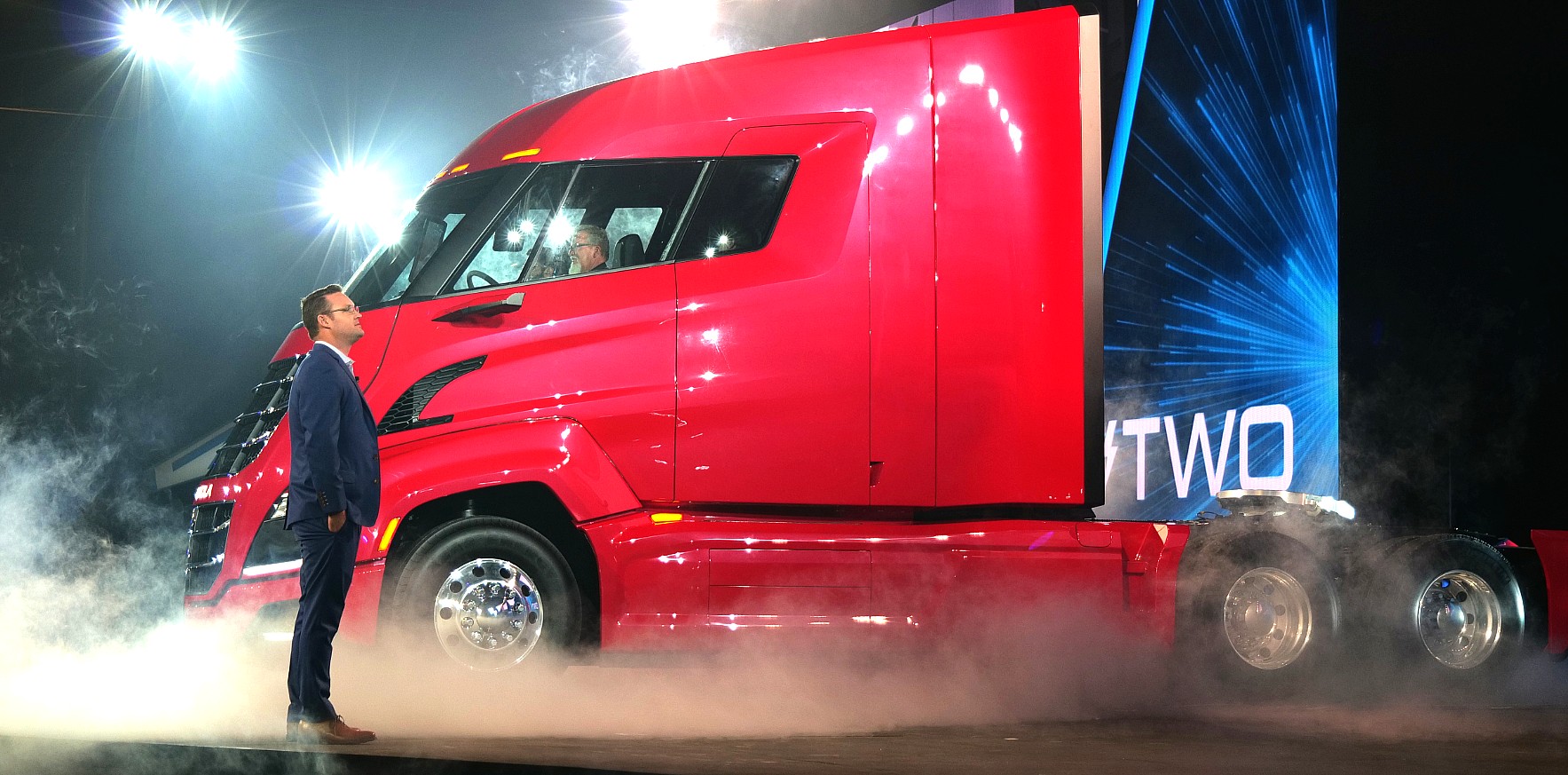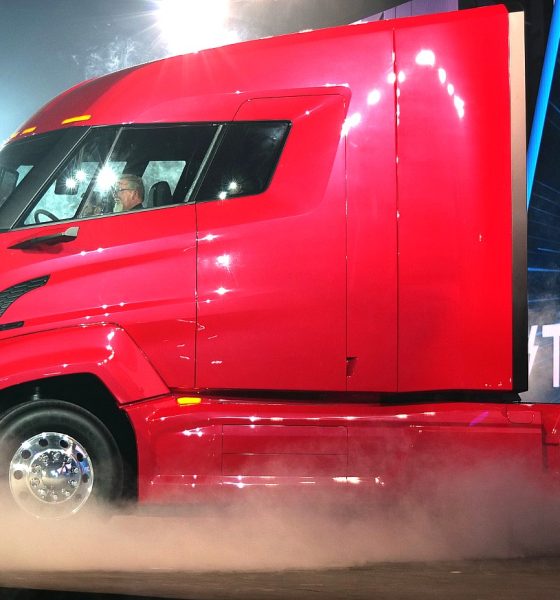

News
Nikola stands firm on H2, but admits EVs like Tesla Semi will dominate in short routes
In a recent interview, Nikola Motor CEO Trevor Milton noted that while electric trucks like the Tesla Semi will likely dominate short-haul jobs in the future, hydrogen is still the key for tomorrow’s long-haul routes. Speaking with trucking-themed publication Trucks.com, Milton provided some insights on his vision for Nikola’s trucks, his company’s electric vehicles, and why hydrogen makes sense as a sustainable source for propulsion.
Nikola Motor is still a small company, and it is attempting to breach a market that is populated by giants such as Volvo and Daimler. To make this endeavor a success, Milton noted that he needs to “build the iPhone of trucking,” which involves an ecosystem that does not just involve a vehicle, but its fueling infrastructure as well.
“Apple would not be Apple if the iPhone was just a phone. We don’t just provide you with the truck. It was about building the best back end a phone has ever had. And that’s what we do with Nikola… We provide you with all the fuel for the first million miles. When you sign on for Nikola we put in a hydrogen station with all your fuel covered, without any cost variation, for seven years. No one else will do that,” Milton said.

Nikola is yet to deploy its trucks to the market, and other disruptive companies like Tesla have unveiled trucks of their own. Tesla, for its part, designed the Semi as a fully-electric truck, just like its other vehicles. Amidst the rising competition in the green trucking segment, Nikola has also expressed its interest in offering battery-only versions of its vehicles. Milton explained this strategy in his recent interview, admitting that for some tasks, battery-electric trucks simply make sense.
“Around long-haul, you have more advantage on the hydrogen side because it’s lighter. It’s all about freight weight, or how much it costs to move a freight-ton per mile. There’s advantages to both infrastructures, but we’re mainly focused on the hydrogen side. We just offer battery-electric so we can tell people we’ll shoot you straight. There are areas where hydrogen does not make sense,” he said.
Nevertheless, the Nikola CEO maintained his stance on hydrogen, arguing that batteries still have disadvantages in terms of weight and cost. Milton also mentioned the ethical issues surrounding lithium mining; an issue that has been closely related to the emerging electric car industry, though he did state that batteries are a “really good solution” for short-haul tasks.

“The battery alone in an electric truck is going to cost $200,000. We’re shooting for an internal cost of $150,000 for our entire Nikola truck. Our truck also weighs less than the batteries in an electric truck. Now, electric is going to kick our butt in short-haul because it’s a really good solution, but electric trucks are not one size fits all. Right now, they’re digging up mines with child labor to pull lithium out to make batteries, and I’m tired of it. The only things that you can use and reuse indefinitely are water and hydrogen. It is the only resource that will not go away. That’s why we picked the hydrogen route.
“Our hydrogen trucks also take a big battery, so I can’t point the finger at anyone else. I have the same problem everybody else has, and I’m trying to get rid of it. The electric powertrain is the powertrain of the future. How we store the energy for it has got to change. We’ve got to figure out a way, whether it’s through ultra-capacitors or whatever it may be, where you can store all that energy without disrupting these scarce resources. Then the price will come down low enough that we can finally win,” Milton stated.
Battery technology continues to improve with the continued adoption of electric propulsion. Tesla, for its part, is working on removing cobalt from its batteries altogether, allowing the company to address the humanitarian issues surrounding cobalt mines in areas such as the Republic of Congo. During the recently held annual shareholder meeting, Tesla CEO Elon Musk even hinted at Tesla potentially entering the mining business, as a means to acquire the necessary materials for its products’ batteries.

Elon Musk
Elon Musk’s X will start using a Tesla-like software update strategy
The initiative seems designed to accelerate updates to the social media platform, while maintaining maximum transparency.

Elon Musk’s social media platform X will adopt a Tesla-esque approach to software updates for its algorithm.
The initiative seems designed to accelerate updates to the social media platform, while maintaining maximum transparency.
X’s updates to its updates
As per Musk in a post on X, the social media company will be making a new algorithm to determine what organic and advertising posts are recommended to users. These updates would then be repeated every four weeks.
“We will make the new 𝕏 algorithm, including all code used to determine what organic and advertising posts are recommended to users, open source in 7 days. This will be repeated every 4 weeks, with comprehensive developer notes, to help you understand what changed,” Musk wrote in his post.
The initiative somewhat mirrors Tesla’s over-the-air update model, where vehicle software is regularly refined and pushed to users with detailed release notes. This should allow users to better understand the details of X’s every update and foster a healthy feedback loop for the social media platform.
xAI and X
X, formerly Twitter, has been acquired by Elon Musk’s artificial intelligence startup, xAI last year. Since then, xAI has seen a rapid rise in valuation. Following the company’s the company’s upsized $20 billion Series E funding round, estimates now suggest that xAI is worth tens about $230 to $235 billion. That’s several times larger than Tesla when Elon Musk received his controversial 2018 CEO Performance Award.
As per xAI, the Series E funding round attracted a diverse group of investors, including Valor Equity Partners, Stepstone Group, Fidelity Management & Research Company, Qatar Investment Authority, MGX, and Baron Capital Group, among others. Strategic partners NVIDIA and Cisco Investments also continued support for building the world’s largest GPU clusters.
News
Tesla FSD Supervised wins MotorTrend’s Best Driver Assistance Award
The decision marks a notable reversal for the publication from prior years, with judges citing major real-world improvements that pushed Tesla’s latest FSD software ahead of every competing ADAS system.

Tesla’s Full Self-Driving (Supervised) system has been named the best driver-assistance technology on the market, earning top honors at the 2026 MotorTrend Best Tech Awards.
The decision marks a notable reversal for the publication from prior years, with judges citing major real-world improvements that pushed Tesla’s latest FSD software ahead of every competing ADAS system. And it wasn’t even close.
MotorTrend reverses course
MotorTrend awarded Tesla FSD (Supervised) its 2026 Best Tech Driver Assistance title after extensive testing of the latest v14 software. The publication acknowledged that it had previously criticized earlier versions of FSD for erratic behavior and near-miss incidents, ultimately favoring rivals such as GM’s Super Cruise in earlier evaluations.
According to MotorTrend, the newest iteration of FSD resolved many of those shortcomings. Testers said v14 showed far smoother behavior in complex urban scenarios, including unprotected left turns, traffic circles, emergency vehicles, and dense city streets. While the system still requires constant driver supervision, judges concluded that no other advanced driver-assistance system currently matches its breadth of capability.
Unlike rival systems that rely on combinations of cameras, radar, lidar, and mapped highways, Tesla’s FSD operates using a camera-only approach and is capable of driving on city streets, rural roads, and freeways. MotorTrend stated that pure utility, the ability to handle nearly all road types, ultimately separated FSD from competitors like Ford BlueCruise, GM Super Cruise, and BMW’s Highway Assistant.
High cost and high capability
MotorTrend also addressed FSD’s pricing, which remains significantly higher than rival systems. Tesla currently charges $8,000 for a one-time purchase or $99 per month for a subscription, compared with far lower upfront and subscription costs from other automakers. The publication noted that the premium is justified given FSD’s unmatched scope and continuous software evolution.
Safety remained a central focus of the evaluation. While testers reported collision-free operation over thousands of miles, they noted ongoing concerns around FSD’s configurable driving modes, including options that allow aggressive driving and speeds beyond posted limits. MotorTrend emphasized that, like all Level 2 systems, FSD still depends on a fully attentive human driver at all times.
Despite those caveats, the publication concluded that Tesla’s rapid software progress fundamentally reshaped the competitive landscape. For drivers seeking the most capable hands-on driver-assistance system available today, MotorTrend concluded Tesla FSD (Supervised) now stands alone at the top.
News
Elon Musk’s Grokipedia surges to 5.6M articles, almost 79% of English Wikipedia
The explosive growth marks a major milestone for the AI-powered online encyclopedia, which was launched by Elon Musk’s xAI just months ago.

Elon Musk’s Grokipedia has grown to an impressive 5,615,201 articles as of today, closing in on 79% of the English Wikipedia’s current total of 7,119,376 articles.
The explosive growth marks a major milestone for the AI-powered online encyclopedia, which was launched by Elon Musk’s xAI just months ago. Needless to say, it would only be a matter of time before Grokipedia exceeds English Wikipedia in sheer volume.
Grokipedia’s rapid growth
xAI’s vision for Grokipedia emphasizes neutrality, while Grok’s reasoning capabilities allow for fast drafting and fact-checking. When Elon Musk announced the initiative in late September 2025, he noted that Grokipedia would be an improvement to Wikipedia because it would be designed to avoid bias.
At the time, Musk noted that Grokipedia “is a necessary step towards the xAI goal of understanding the Universe.”
Grokipedia was launched in late October, and while xAI was careful to list it only as Version 0.1 at the time, the online encyclopedia immediately earned praise. Wikipedia co-founder Larry Sanger highlighted the project’s innovative approach, noting how it leverages AI to fill knowledge gaps and enable rapid updates. Netizens also observed how Grokipedia tends to present articles in a more objective manner compared to Wikipedia, which is edited by humans.
Elon Musk’s ambitious plans
With 5,615,201 total articles, Grokipedia has now grown to almost 79% of English Wikipedia’s article base. This is incredibly quick, though Grokipedia remains text-only for now. xAI, for its part, has now updated the online encyclopedia’s iteration to v0.2.
Elon Musk has shared bold ideas for Grokipedia, including sending a record of the entire knowledge base to space as part of xAI’s mission to preserve and expand human understanding. At some point, Musk stated that Grokipedia will be renamed to Encyclopedia Galactica, and it will be sent to the cosmos.
“When Grokipedia is good enough (long way to go), we will change the name to Encyclopedia Galactica. It will be an open source distillation of all knowledge, including audio, images and video. Join xAI to help build the sci-fi version of the Library of Alexandria!” Musk wrote, adding in a later post that “Copies will be etched in stone and sent to the Moon, Mars and beyond. This time, it will not be lost.”








